The Cattle Climate Connection
Air Date: Week of December 4, 2009
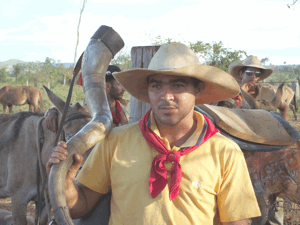
The behanche is an instrument made from a steer’s horn, used to draw the cows together. (Photo: Bobby Bascomb)
Brazil is the world’s 4th largest emitter of greenhouse gasses. The majority of those emissions are from the destruction of the Amazon forest. In the past loggers were mainly to blame but today cattle are driving deforestation, as 80 percent of the cleared land is converted to cow pasture. To preserve what’s left of the forest and stall climate change the United Nations has proposed a plan known as REDD, Reducing Emissions from Deforestation and Degradation. Living on Earth’s Bruce Gellerman and Bobby Bascomb travel to the Amazon to investigate the connection between cows and climate change.
Transcript
CURWOOD: From the Jennifer and Ted Stanley studios in Somerville, Massachusetts this is Living on Earth. I’m Steve Curwood. Climate scientists estimate the destruction of the planet’s tropical forests emit as much greenhouse gases each year as all forms of transportation combined. The Amazon of Brazil is the largest remaining tropical forest. So far the billions spent on conservation and law enforcement have failed to keep an area the size of France from being cut down, and deforestation continues.
Some say the least expensive, fastest way to preserve what’s left of the world’s tropical forest is to change incentives with a mechanism known as REDD. Reducing Emissions from Deforestation and Degradation is simple in principle: make it more profitable to keep the forest standing than cut down. Simple perhaps but not easy, as Living On Earth’s Bobby Bascomb and Bruce Gellerman found as they journeyed to Brazil in search of the REDD Path for a Green Planet.
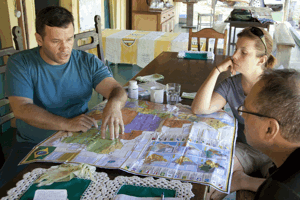
Marco Lima, Bobby Bascomb, and Bruce Gellerman mapping out their trip through the Amazon. (Photo: Lauren Oaks)
[ROAD SOUNDS]
GELLERMAN: Bobby and I spent a month traveling through the Amazon.
BASCOMB: We drove 5,000 long, dusty miles.
GELLERMAN: We just passed a sign that said Porto Vehlo: 1029 kilometers.
LIMA: Yep.
GELLERMAN: And that’s – that’s where we’re going.
LIMA: Yes, sir, that’s how much we need to do.
BASCOMB: That’s Marco. Marco Lima, our guide and driver. He’s short, stocky and fills out his safari shirt. Marco came with all the right credentials: he’s a fish biologist, jungle survival-combat vet, and a gifted gabber.
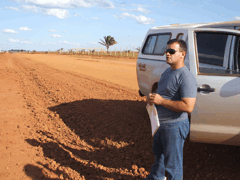
Marco Lima stands in front of our truck on the Trans-Amazon Highway. He was our interpreter, naturalist guide, and driver for 5 weeks and 5,000 miles across the Amazon. (Photo: Bobby Bascomb)
LIMA: …who told me we have enough forest and I disagreed.
[SOUNDS OF TRUCK ON ROAD]
GELLERMAN: Marco picked us up in the special truck he uses for trips through the jungle. It’s a heavy-duty suspension job with dual fuel tanks, and just in case, Marco put a machete under the driver’s seat.
BASCOMB: Get stuck out here in the Amazon frontier and you’re in trouble.
LIMA: If you look into this vegetation, what you can see that – watch out Bobby.
[FIRE CRACKLING SOUNDS]
GELLERMAN: Wow did you see that? It just leapt over there.
[FIRE CRACKLING]

After a rancher buys a piece of land he sells the valuable logs and burn what remains to improve the quality of the soil. This fire started on the side of the road in a previously cleared pasture of cattle grass. (Photo: Bobby Bascomb)
GELLERMAN: Fire. The side of the road is ablaze. We’re hundreds of miles south of the dense Amazon jungle driving through scrub savannah grasslands, and fire season is still a month away, but the place is a tinderbox.
LIMA: It sounds like crazy, Bruce, but a fire like this, if in the years we have less rain intensity this could burn the whole Amazon.
BASCOMB: So nobody will come along to put this fire out?
LIMA: No, this fire is waiting for the next rain.
BASCOMB: It could be a long wait. These days there’s less rain in the rain forest because there’s less forest. Scientists say deforestation is drying the Amazon. The rainy season comes later than it used to, and fires have become more intense.
GELLERMAN: The fires are usually set by settlers and speculators who slash and burn the trees to clear the land for logs and agriculture. In this part of the Amazon, an acre of forested land goes for about 175 dollars. Cleared of trees that same acre sells for about 12 hundred. It’s a no brainer – deforestation pays.
[STREET SOUNDS]
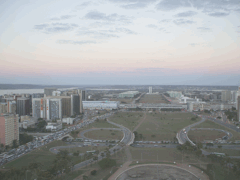
Brasilia, the capitol of Brazil, is a new city built just 40 years ago. It was designed with wide multi-lane streets and cement buildings. The Brazilian government moved the capitol from the coast to the interior to encourage people to settle the frontier. (Photo: Bobby Bascomb)
BASCOMB: The city of Brasilia is a product of that deforestation. In the 1960’s the government built a new capitol here. To spur development of the region they built a concrete jungle at the edge of the Amazon forest. It’s here in Brasilia that we met Paulo Moutinho.
GELLERMAN: Paulo Moutinho studies Amazon ants but these he days spends most of his time as Director of the Climate Change Program at IPAM – the Amazon Institute for Environmental Research. According to Moutniho, Brazil is the world’s fourth largest producer of greenhouse gases. And what’s really amazing is that three quarters of those emissions come from the deliberate destruction of the Amazon.
MOUTINHO: It’s like a container – a huge container of carbon – if you open that and cut trees, burning trees you produce a huge amount of emission of carbon, producing more global warming.
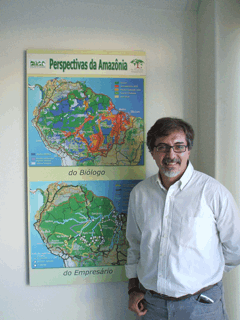
Dr. Paulo Moutinho is director of IPAM, The Amazon Institute for Environmental Research. (Photo: Bobby Bascomb)
GELLERMAN: So, the trees store a lot of carbon and you want to keep it in the trees.
MOUTINHO: Exactly. Without Amazon forest you have a big problem in terms of climate change.
GELLERMAN: Twenty percent of the Amazon is already gone but still locked within the trees is the equivalent of 50 years of US carbon dioxide emissions. Keeping all that carbon in the trees will take big bucks: tens, maybe hundreds of billions of dollars. To raise it, Moutinho advocates REDD, Reducing Emissions from Deforestation and Degradation. He says REDD is a way to make money from trees without cutting them down.
MOUNTINHO: I think that we need economic mechanism to save a large portion of tropical forest. We’re talking about area equivalent of all Europe.
GELLERMAN: There are many shades of REDD and ways to fund it. Moutinho favors a market mechanism. Money to save the forest would come from selling carbon credits to companies and countries that need to offset their climate disrupting emissions.
BASCOMB: Brazil’s president Luiz Inacio Lula de Silva wants to take a different road to REDD. Lula’s REDD program is funded by contributions. He wants polluting nations to donate 21 billion dollars to what he calls The Amazon Fund. There would be limited private carbon trading, most of the money would be controlled by the government.
They’d use the funds to monitor and preserve the forest.
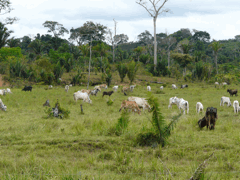
80 percent of deforestation in the Amazon is a result of raising cattle. (Photo: Bruce Gellerman)
BASCOMB: Alberto Lourenco works for Lula. He’s Assistant Secretary of Sustainable Development and in charge of The Amazon Fund.
LOURENCO: REDD could be important piece of many-sided solution to deforestation and to sustainable development in the Amazon. But so far it’s not – we are just beginning to experiment with REDD. You know the numbers are not even close to the amount of money that is supplied to pequaristas to cattle ranchers in the Amazon.
BASCOMB: Out of the 21 billion dollars Lula’s Amazon Fund hopes to collect just 118 million dollars in donations have come in. And not a single penny has been spent.
Meanwhile, Brazil spends 600 million dollars a year to expand agriculture into the Amazon forest.
GELLERMAN: Much of the money goes to a few huge Brazilian cattle ranchers to satisfy the world’s soaring appetite for beef. In the last ten years per capita consumption of beef has more than doubled in China. And in the last 15 years here in Brazil, beef consumption has tripled.
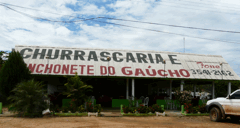
Most towns in Brazil have at least 1 churrascaria restaurant. (Photo: Bruce Gellerman)
[SOUNDS OF VOICES TALKING]
GELLERMAN: Brazilians love barbeque – Churasscaria is a cultural institution.
[SHARPENING OF KNIVES]
GELLERMAN: At Chursasscaria Bufalo in the Amazon city of Manaus, waiters carry long skewers of meat and sharp knives. You can eat as much as you want from any one of 29 different cuts of beef.
MAN: [Translation] Our people really love grilled food, and of course, as beef is very cheap food that’s why it really became part of our daily diet.
GELLERMAN: So you eat beef every day.
MAN: [Translation] Almost every day. On my day off I eat fish [Laughs].
GELLERMAN: There are people that say that beef is a problem because it causes environmental concerns. What do you think of that?
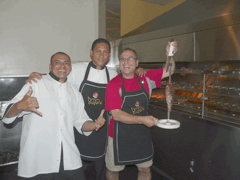
Bruce Gellerman with churrascaria waiters. (Photo: Bobby Bascomb)
MAN: [Translation] It is true, I agree, but it is not a major fact for the deforestation. I think the reason for the big deforestation are definitely the big logging companies.
BASCOMB: Logging used to be the driving force of Amazon deforestation, but in the 1990’s things changed dramatically.
[CATTLE BELL SOUNDS]
BASCOMB: Today, cattle is driving deforestation. The Amazon is rapidly being turned into ranch land.
[ROAD SOUNDS; COW BELLS; COW MOO-ING; HORNS]
BASCOMB: It’s rush hour Trans-Amazon style. We’re stuck behind nine cowboys on horseback and a thousand head of cattle. The cowboys are driving the cattle down the middle of the road in the Amazon state of Para.
[MAN YELLING]
BASCOMB: They use a dog and a behanche, made from a steer’s horn, to keep the herd together.
[HORN SOUNDS; BELL SOUNDS]

The behanche is an instrument made from a steer’s horn, used to draw the cows together. (Photo: Bobby Bascomb)
BASCOMB: Para is nearly twice the size of Texas and what was once dense forest is now cow pasture. Over the past 20 years, the number of cattle in the Brazilian Amazon has quadrupled. Today, 80 percent of the deforested land in the Amazon is used to raise and graze cows. The deforested area is the size of Japan.
[HORNS AND MOOING SOUNDS]
GELLERMAN: The cows are mostly Nelore – bred to survive the intense Amazon climate. The cowboys are also a breed apart; taciturn and tough.
[REPEATED HORN SOUNDS]
GELLERMAN: They’re driving this herd from a pasture in the northern Amazon to a ranch 700 miles to the south.
[HORN SOUNDS CONTINUE]
GELLERMAN: And how long will it take you to transfer the cattle from where you started to where you are going?
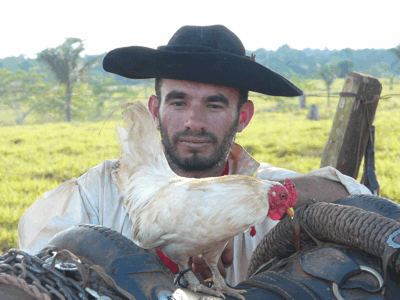
The Amazon cowboys use a rooster as their alarm clock. (Photo: Bobby Bascomb)
MAN:[Translation] Around 70 days.
GELLERMAN: You’re going to be in the saddle 70 days? That’s like the old west. That’s unbelievable.
MAN: [Translation] Welcome to the North – that’s how we manage our life.
[COW BELLS]
GELLERMAN: But life in the Amazon could soon change. Within a decade, Brazil plans to intensify beef production in the region and double it’s share of the international market. And at the same time the government wants to reduce deforestation in the Amazon by about 40 percent.
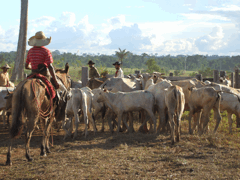
Once dense rainforest, the cowboys move this herd past farmer’s fields and through communities built on the Trans-Amazon. (Photo: Bobby Bascomb)
BASCOMB: But that’s not good enough for Greenpeace Brazil. The environmental group says the goal should be zero deforestation. Their report called “Slaughtering the Amazon” focused attention on the link between the cattle industry and destruction of the forest. Even Greenpeace was surprised by the news media’s reaction.
[WOMAN SPEAKING PORTUGUESE ON BRAZILIAN NEWS SEGMENT]
Ana Maria Braga video about cattle and deforestation
BASCOMB: Brazil's leading morning talk show aired a ten-minute story based on the Greenpeace investigation.
[NEWS SEGMENT CONTINUES]
BRITO: That hit the note with the Brazilian consumers.
BASCOMB: Kiko Brito is a spokesman for Greenpeace Brazil. The report, “Slaughtering the Amazon” spread like wild fire and reads like an indictment. It charges the Brazilian government with financing the destruction of the forest with billions of dollars in loan guarantees to cattle ranchers. And it provides detailed evidence linking international companies to the deforestation of the Amazon. The report tracks their purchase of leather and beef from illegally deforested land.
BASCOMB: Kiko Brito says “Slaughtering the Amazon” names names:
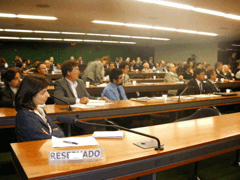
Government representatives from all over Brazil meet to discuss the Greenpeace report, “Slaughtering the Amazon.” (Photo: Bruce Gellerman)
BRITO: Adidas, Nike, Gucci. As we say in Brazil, this was the first report that gave name to the ox. In other words, we put the names behind the use of cattle to deforest the Amazon.
GELLERMAN: Word of the Greenpeace report hit the Brazilian cattle industry where it hurts: the consumer. Within days, Adidas, Nike, Gucci and the three largest supermarkets in Brazil had heard enough. They announced a moratorium, promising not to buy products produced from cows raised on illegally deforested Amazon land.
BRITO: When a supermarket says it will no longer buy meat from deforested areas it's not doing it because it is a nice supermarket, but because they heard something from people who are buying from their shelves.
[VOICE YELLING IN PORTUGUESE]
GELLERMAN: Greenpeace also heard something: angry congressmen from Amazonian states.
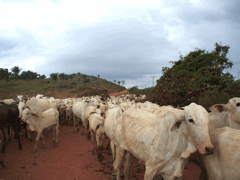
Cowboys use the Trans-Amazon highway to drive the cattle herd. (Photo: Bruce Gellerman)
BASCOMB: Brazil’s Chamber of Deputies held a special hearing after Greenpeace released its report.
[MAN YELLING]
BASCOMB: One member of congress shouted, “take Greenpeace out in handcuffs.” Another demanded Greenpeace accept economic reality.
CONGRESSMAN: [Translation] Yes, the Amazon is important but what are you going to do with the 25 million people living there?
[MAN YELLING CONTINUES]
GELLERMAN: Greenpeace organizers were visibly shaken by the angry response they got in congress. And even wondered if it was safe to meet with cattle ranchers in the Amazon the next day. According to Joao Talocchi of Greenpeace the group often receives death threats so organizers drive in armored vehicles.
TALLOCCHI: For more than 400 murders that happen in the Amazon. Not even one is arrested. So, there’s no governance, there’s no law enforcement in the Amazon right now.
Links
Living on Earth wants to hear from you!
Living on Earth
62 Calef Highway, Suite 212
Lee, NH 03861
Telephone: 617-287-4121
E-mail: comments@loe.org
Newsletter [Click here]
Donate to Living on Earth!
Living on Earth is an independent media program and relies entirely on contributions from listeners and institutions supporting public service. Please donate now to preserve an independent environmental voice.
NewsletterLiving on Earth offers a weekly delivery of the show's rundown to your mailbox. Sign up for our newsletter today!
 Sailors For The Sea: Be the change you want to sea.
Sailors For The Sea: Be the change you want to sea.
 The Grantham Foundation for the Protection of the Environment: Committed to protecting and improving the health of the global environment.
The Grantham Foundation for the Protection of the Environment: Committed to protecting and improving the health of the global environment.
 Contribute to Living on Earth and receive, as our gift to you, an archival print of one of Mark Seth Lender's extraordinary wildlife photographs. Follow the link to see Mark's current collection of photographs.
Contribute to Living on Earth and receive, as our gift to you, an archival print of one of Mark Seth Lender's extraordinary wildlife photographs. Follow the link to see Mark's current collection of photographs.
 Buy a signed copy of Mark Seth Lender's book Smeagull the Seagull & support Living on Earth
Buy a signed copy of Mark Seth Lender's book Smeagull the Seagull & support Living on Earth

